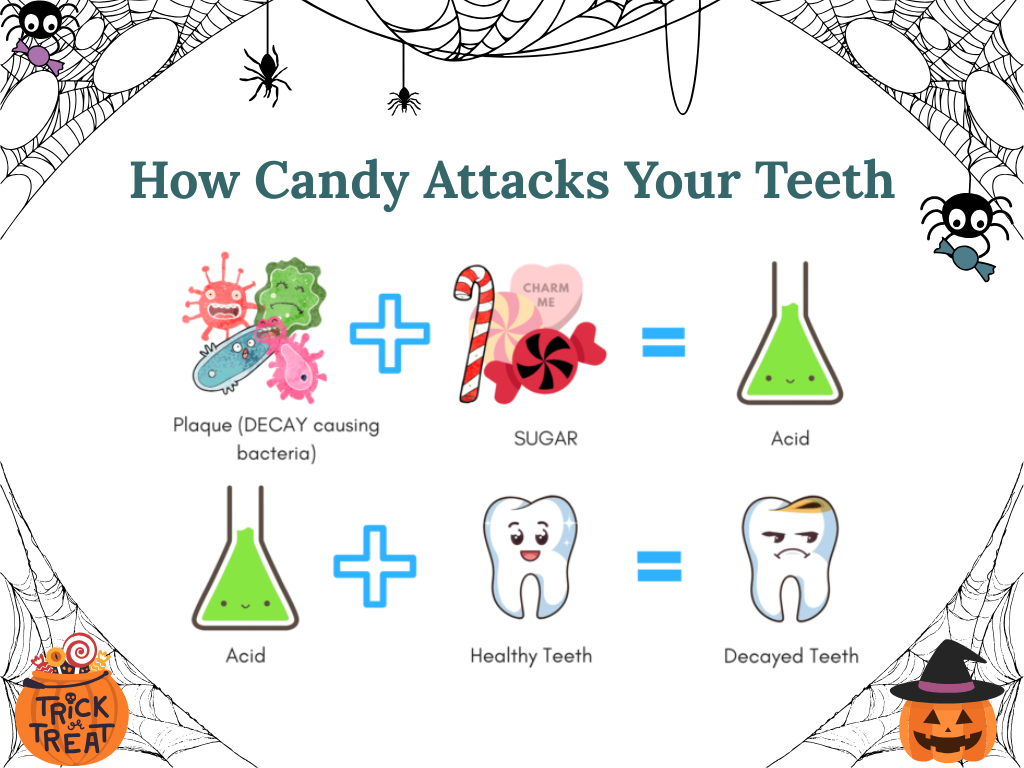

Expert dental tips, news, and smile advice
A Halloween Story About Tiny Teeth and Big Lessons
October 10, 2025
By Admin
The Chocolate Dilemma
When six-year-old Mia got home from trick-or-treating, her orange pumpkin bucket was bursting at the seams—mini chocolate bars, lollipops, sticky caramels, and a few mysterious candies she wasn’t sure how to unwrap. Her mom, Carla, sighed and smiled.
“Okay,” she said, setting down the bowl she’d been handing out to the neighborhood kids. “Two pieces tonight, then the rest for later.”
Mia’s grin widened, chocolate already melting on her fingers.
By Monday morning, though, the excitement had dulled—and something else had begun to brew.
Mia complained her tooth “felt funny” when she chewed her breakfast. Carla brushed it off at first—maybe something stuck? But by Wednesday, the “funny feeling” had turned into full-on pain. The timing couldn’t have been worse: Halloween weekend had barely ended, and the candy stash was still hidden (badly) in the pantry.
That’s how Carla found herself at Tiny Tooth Co., watching Dr. Sarah gently examine her daughter’s molar with a tiny mirror and a reassuring smile.
The Real Halloween Scare
%202.jpg)
Dr. Sarah explained what most parents dread hearing: the Halloween cavity. It wasn’t unusual—October through December is what many pediatric dentists call “candy season,” when sugar intake quietly spikes and brushing routines get rushed.
But what surprised Carla wasn’t just that Mia had a cavity—it was how quickly it had formed.
“Sugar itself isn’t the villain,” Dr. Sarah explained, turning the screen toward them. “It’s the time sugar spends on the teeth that matters. Bacteria feed on it and create acid, which starts softening enamel within minutes.”
Carla frowned. “So all those little bites throughout the day…?”
Dr. Sarah nodded. “Exactly. A candy here, a lollipop there—it keeps the mouth in an acid cycle all day long.”
The Science Behind the Sweetness
Most parents assume cavities appear slowly, over months or even years. But pediatric enamel is thinner than adult enamel—meaning damage can happen fast.
Sticky, chewy candies are the biggest culprits because they cling to grooves and between teeth. Hard candies extend sugar exposure with every minute they dissolve. Even seemingly harmless gummies and fruit snacks can be stealthy offenders.
Dr. Sarah shared something else that resonated: “Your child’s teeth are like a playground—strong, but they need breaks between rides. Water rinses and brushing are like the cleanup crew that resets everything before the next round.”
Carla laughed, but it clicked.

How Mia’s Visit Became a Lesson
Mia needed a small tooth-colored filling—a quick, simple procedure. But the visit became much more than treatment.
Dr. Sarah showed Mia her “sugar bugs” on the screen, explaining how they “throw tiny parties” every time she snacks without brushing. Mia giggled, and suddenly the fear of the dentist turned into curiosity.
As the visit wrapped up, Dr. Sarah handed Mia a new toothbrush and a sticker that said Cavity Crusher. Carla felt relief wash over her.
“Next Halloween,” she said, “we’ll have a better plan.”
Ready to Transform Your Smile?
If your child’s post-Halloween smile needs a little checkup, or if you’d just like guidance on cavity prevention, schedule a gentle cleaning or exam. We’ll make sure the only thing spooky this season is the costumes.
Discover the best solution for your smile at Tiny Tooth Company. Schedule your appointment now and let our expert team guide you to a confident, healthy smile.

Turning Candy Season Into Learning Season
Halloween may only last a night, but the candy seems to stick around for weeks—and not just in the pantry. This time of year is the perfect opportunity to turn sweet temptations into teachable moments. Instead of making candy the villain, you can use it to help kids understand balance, build better brushing habits, and take pride in caring for their smiles. Here’s how to turn post-Halloween sugar rushes into small, meaningful lessons that last long after the costumes are packed away.
1. Timing is Everything - Candy is best eaten with meals, not as random snacks. When we eat, saliva production increases, which naturally helps wash away sugar and neutralize acid.
2. The Power of Water - Encourage your child to drink water right after candy—especially fluoridated tap water. It’s the simplest way to stop acid attacks before they start.
3. Sorting for Success - Let your child keep a few favorites and donate the rest to a candy buy-back or community drive. In The Woodlands, some local dentists (including Tiny Tooth Co.) participate in post-Halloween programs that trade candy for small prizes.
4. Watch the Sticky Stuff - Caramel, gummies, and taffy cling to enamel far longer than chocolate. When in doubt, chocolate’s your safest bet—it melts away fast.
5. Make Brushing a Game - Turn brushing into a two-minute challenge with a Halloween playlist or sand timer. The goal? Brush away those “sugar bugs” before they regroup.

A Quick Note from Dr. Sarah
“Parents often feel guilty around Halloween,” Dr. Sarah said later. “But candy isn’t the enemy. It’s about habits. I’d rather a child enjoy a treat and brush well afterward than feel restricted and sneak sweets later. What we teach now shapes how they care for their teeth for life.”
That perspective is at the heart of Tiny Tooth Co.’s philosophy—prevention through partnership. Every visit is an opportunity to educate, empower, and encourage families, not just treat cavities.
What Parents Can Take Away

Carla admitted she used to see dental care as a reactive thing—something you do after a problem arises. Now, it’s part of their daily rhythm.
They started using sugar-free gum after meals and brushing together each night. By the time Mia’s six-month checkup rolled around, she marched into the office with confidence and no new cavities.
“It’s funny,” Carla said. “That little cavity taught us more than a dozen lectures ever could.”
The Real Trick to a Treat
Halloween doesn’t have to mean cavities. It’s a chance to build conversations about balance, brushing, and being mindful of what goes into those tiny mouths.
It’s also a reminder that dental visits don’t need to feel scary or reactive—they can be proactive, positive, and even fun.
FAQ Section
1. How soon should my child visit after Halloween?
A quick checkup within a few weeks is ideal—especially if your child mentions tooth sensitivity or pain while eating. Tiny Tooth Co. offers preventive cleanings that help remove lingering plaque from sweets.
2. Are some Halloween candies safer for teeth than others?
Yes. Chocolate (especially dark chocolate) melts away quickly, making it less harmful than sticky or sour candies, which cling to enamel and increase acid exposure.
3. Can fluoride really help prevent cavities?
Absolutely. Fluoride strengthens enamel and reverses early decay. Using fluoridated toothpaste and drinking tap water are easy, everyday ways to keep cavities away.
4. What if my child is scared of the dentist?
At Tiny Tooth Co., we specialize in helping children feel safe and confident. From calm communication to positive reinforcement, our visits are designed to turn nervous patients into dental superstars.
5. What’s the best way to limit candy without arguments?
Involve your child in the process! Let them choose a few favorites to keep, and donate or trade the rest. Turning it into a game helps avoid power struggles and teaches moderation.
Request An Appointment
Book an Appointment
Thank you! Your submission has been received!
Oops! Something went wrong while submitting the form.
Schedule your child’s dental appointment at Tiny Tooth in The Woodlands, led by Dr. Sarah Arafat! We specialize in pediatric dental care in a friendly environment. Schedule today for expert care and a healthy smile that lasts a lifetime!
.gif)
.webp)

